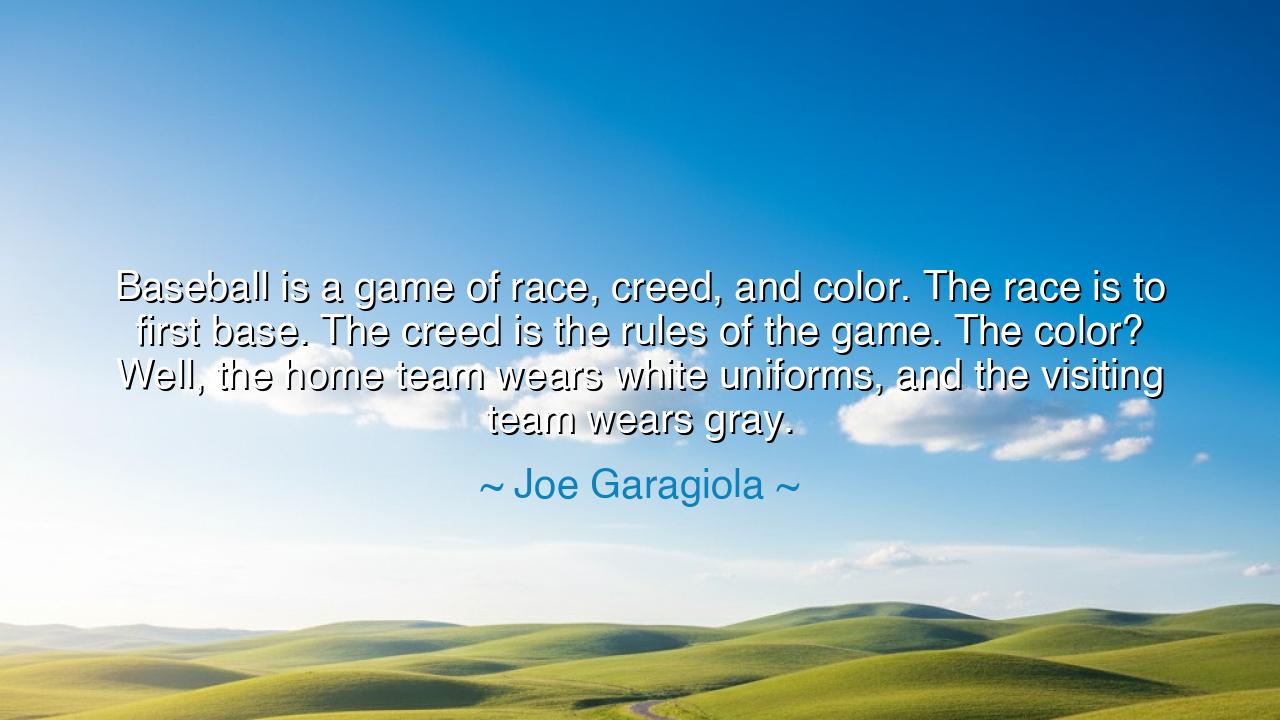
Baseball is a game of race, creed, and color. The race is to
Baseball is a game of race, creed, and color. The race is to first base. The creed is the rules of the game. The color? Well, the home team wears white uniforms, and the visiting team wears gray.






In the book of summer and chalked lines, a catcher turned bard speaks in riddling clarity: “Baseball is a game of race, creed, and color. The race is to first base. The creed is the rules of the game. The color? Well, the home team wears white uniforms, and the visiting team wears gray.”** So says Joe Garagiola, and the jest lands like a pebble that ripples a deep lake. His words play with the charged trinity—race, creed, color—only to turn them from blood and banner to sprint, statute, and jersey. Humor becomes a house-cleaning wind: it clears the air so we can speak of what makes a team a team—effort, order, and the shared costume of the day.
The first note is swiftness: the race to first base. Before politics, before press, there is the living dash—the crack of wood, the heartbeat in the throat, the dirt that leaps under cleats. In this race, no passport helps, no pedigree hinders. Speed, read, courage—these decide the step. Garagiola reminds us that beneath the grandstands of opinion there is always the simple measure of motion: did you run, and did you run hard?
The second note is covenant: the creed that is the rules of the game. Umpires may be mortal, but the code is a kind of scripture—strike zone, ninety feet, three outs singing the hours. Between strangers who might differ in every other creed, this one holds sway: touch the bag, tag the runner, accept the call. In a noisy world, baseball’s creed teaches the old civic art—submit to a common law so that play, and not quarrel, may flourish.
The third note is belonging worn on the body: color as uniforms—white for the home team, gray for the road. Here Garagiola turns a volatile word into a harmless banner. Color ceases to divide the flesh and instead unites the side: the jersey says, “We.” Home’s white is not purity but hospitality; gray’s dust is not exile but pilgrimage. This playful reframing does not deny history; it proposes a way to live together inside it—by choosing colors we can change at day’s end without changing the worth of those who wear them.
Yet the diamond has known heavier weather. Let one story walk beside the jest so the lesson stands firm. In 1947, Jackie Robinson crossed the line that should never have been drawn, shouldering jeers with the stillness of tempered steel. The race to first base was the same, the creed of rules unchanged, the color of a uniform ordinary; but the color of his skin confounded the age. Many shrank; some stood tall. Pee Wee Reese, in a hostile park, placed a quiet arm over Robinson’s shoulders—an ancient gesture that said, “These are my colors; this is my brother.” The crowd did not vanish; the venom did not cease. But the game began to teach the nation what Garagiola’s line enacts in miniature: when we talk about race, creed, and color, let us mean hustle, fairness, and team.
Another witness is Roberto Clemente, who wore Pittsburgh’s colors like a vow. He ran every grounder as if angels were timing him; he enforced the creed of excellence with the stern kindness of a captain; he made color—of jersey, of language, of heritage—not a wedge but a bridge. He died ferrying relief to the broken, a right fielder turned right-doer; and the stadium learned that the best uniform is character stitched to courage.
What, then, shall we teach the dugouts of our lives—families, schools, companies, cities? First, let the race be about effort: reward the run, not the rumor. Second, keep the creed clear and applied to all: one rulebook, no secret innings. Third, wear your colors lightly and proudly: let symbols unite rather than sort souls into lesser and greater. Remember that humor, rightly used, is not evasion but invitation—a way to coax hard truths onto the field without turning the bleachers into a battlefield.
Take these actions as provisions for the long season. (1) In any team you join, define the “first base” that earns respect—show up on time, own your errors, sprint on contact—and celebrate it aloud. (2) Post your “rules of the game” where all can see; enforce them evenly, forgive cleanly, and appeal fairly. (3) Choose uniforms—rituals, slogans, colors—that bind without belittling; trade any emblem that teaches contempt. (4) When history’s shadows lengthen, tell the stories—Robinson, Clemente, Doby—that braid courage to craft. (5) And when speech grows hot, attempt Garagiola’s alchemy: a joke that lifts, not wounds; a turn of phrase that returns us to play, where the measure is the run, the law is the rulebook, and the color is the jersey we share for nine innings before we shake hands beneath the setting sun.






AAdministratorAdministrator
Welcome, honored guests. Please leave a comment, we will respond soon